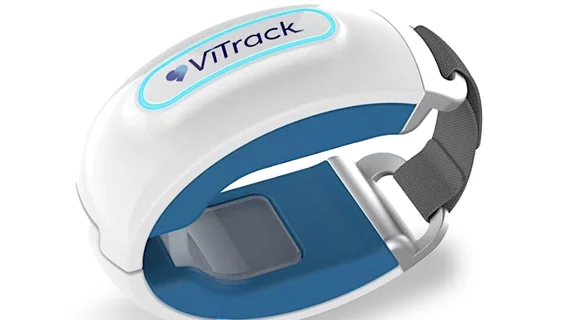NIH awards commercialization grant for wrist-worn continuous ICU-grade blood pressure monitor
The National Heart, Lung, and Blood Institute (NHLBI), part of the National Institutes of Health (NIH), has awarded start up company Dynocardia, a $500,000 grant under its Commercial Readiness Pilot (CRP) Program. The funding will be used to accelerate the development of its ViTrack cNIBP wrist-worn monitor that offers continuous blood pressure (BP) measurement for hospitalized patients to avoid the need for invasive BP catheter monitoring.
The wearable monitor offers a more convenient way for patients to monitor BP. The company said it has rigorously tested the ViTrack technology against the invasive arterial lines typically used in operating rooms and intensive care units (ICUs), which are the company’s initial target markets for commercialization. In clinical studies, the technology demonstrated the ability to deliver accurate and reliable, continuous, noninvasive monitoring of systolic and diastolic BP using the wrist-worn device.
The company said the grant will be used to complete verification and validation testing, followed by a premarketing submission to the U.S. Food and Drug Administration (FDA).
The NIH has consistently highlighted the critical need for accurate BP monitoring in enhancing public health. In 2015, the founders of Dynocardia responded to the NIH's call for new technologies for accurate BP monitoring and developed ViTrack technology. The technology incorporates a proprietary optical force sensor and a unique approach to accurately measure continuous BP and other heart function parameters. Dynocardia said over the last three years it has received nearly $5.1 million in funding from the NHLBI.
“The continued support of the NHLBI is a powerful vote of confidence regarding the potential for ViTrack technology to significantly change clinical practice and benefit millions of patients globally,” said Mohan Thanikachalam, MD, cardiac surgeon, founder and CEO of Dynocardia, and research assistant professor for public health and community medicine, Tufts University, said in a statement.
Standard arm-cuff BP monitors are often inaccurate and can result in monitoring gaps in hospitals and other clinical care settings. The company said this can result in undetected episodes of hypotension during critical illness, surgeries and post-surgical recovery. Dynocardia said these undetected and untreated episodes are associated with large numbers of heart attacks, kidney damage and mortality in U.S. hospitals.
“Routine vital sign monitoring at four to six-hour intervals misses many episodes of dangerously low or high blood pressure,” explained Daniel I. Sessler, MD, professor in the Department of Anesthesiology and vice-president for clinical and outcomes research at UTHealth Houston, said in a statement. He participated in preclinical trials for the ViTrack technology. “Continuous monitoring will allow clinicians to identify patients who are doing poorly and to intervene to get them back on the path to recovery.”

